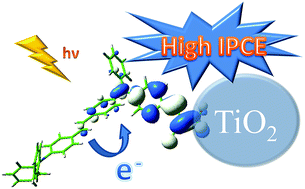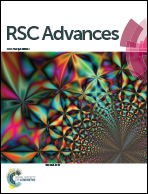New organic dyes with high IPCE values containing two triphenylamine units as co-donors for efficient dye-sensitized solar cells†
Abstract
Here we report the synthetic routes as well as the structural and electronic properties of five new triphenylamine-based organic dyes and their application in dye-sensitized solar cells. In the designed dyes, two triphenylamine groups act as the electron donor units and the electron acceptor is a cyanoacrylic acid, and these units are linked by different π-conjugated spacers including thiophene, dioctylfluorene, ethylcarbazole, and benzo-dithiophene. Density functional theory was employed to study the electron distribution and the intramolecular charge transfer (HOMO–LUMO) of the dyes. Extending the π-conjugation of the dyes broaden and red-shift the bands and improves the light-harvesting ability, however, a device made with triphenylamine maximizer-based dye TPAM-1 without a π-conjugated spacer exhibited the best photovoltaic performance with a short-circuit photocurrent density (Jsc) of 11.37 mA cm−2, an open-circuit voltage (Voc) of 0.836 V, and a fill factor (FF) of 0.603, corresponding to an overall power conversion efficiency of 5.67% under AM 1.5 irradiation (100 mW cm−2).


 Please wait while we load your content...
Please wait while we load your content...